Apparently, new motorcycle companies are like fine wine-they take a number of years to mature and tempt the palate. Following this paradigm, Victory motorcycles have come a long way in the first seven years of production. In the beginning the bikes were somewhat conservative in appearance and performance, but more recently this newest division of Polaris Industries has been introducing a steady stream of brash new models that are extremely competitive with other brands out there in cruiser land.
Based on the widely acclaimed Vegas model this latest iteration, the very extroverted 2005 Victory Hammer, also beats its competition in several important areas. Besides the bike’s overall eye-catching appearance, that ultra-fat 250-width rear tire mounted on an 8.5-inch rim is the widest of all the mass-production bikes. The six-speed gearbox is also a first in production big-twin cruisers and is sure to start a trend. Don’t be surprised if that other American brand starts to offer six speeds as standard soon. And that 100-inch motor is near the top of the American-made V-twin displacement heap.
The beating heart of the Hammer-like all current Victory models-is an air/oil-cooled 50-degree V-twin with single overhead camshafts and four valves per cylinder. Those eight poppets are actuated by maintenance-free hydraulic lifters and self-adjusting cam chains. This layout promises considerably more power than a conventional pushrod cruiser engine design.
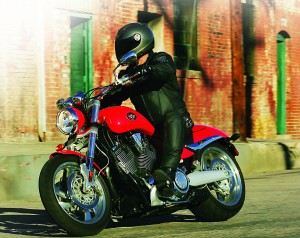
Using Victory’s second-generation V92 (1,507cc) Freedom engine that’s standard on the Vegas as a foundation, the Hammer’s larger 100-cubic-inch (1,634cc) displacement was achieved by boring it out 1?5 inch, from 3.82 inches up to 4.02; stroke remains at 3.98 inches. The compression ratio is bumped up slightly from 9.2 to 9.8:1, which yields a little extra zip, too.
Both versions (92 and 100 cubic inches) are built on the same assembly line in Osceola, Wisconsin. Victory reports that it has the lowest warranty claim rate of all Polaris engines and is said to be among the best in the whole powersports industry. So far our experience has borne that out. There were no leaks, seeps, weeps or other untoward occurrences from within the crankcase halves.
Besides the increase in bore size, the Hammer’s engine received a redesigned camshaft drive, oil pump and primary drive. This was done at least in part to reduce mechanical whirring noises, which some folks found objectionable.
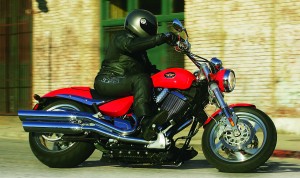
The crankcase casting was narrowed 10mm and the frame cradle was also narrowed to match for improved cornering clearance. As a result, oil capacity was reduced from six to five quarts, but that’s still as much oil capacity as many V-8 automotive engines. We were told that the original engine was over-engineered and this change won’t affect engine life or performance.
Twist the cold-start lever on the left handlebar, thumb the starter and the big twin rumbles to life immediately and settles quickly into a steady idle even when cold. In warmer weather you can even skip the fast-idle lever. Rideability is good and the bike responds to the throttle obediently. There is an initial abrupt jump in power coming up off idle and a light surge when coasting down to a stop, which is produced when the fuel-cut strategy (designed to reduce exhaust emissions) turns the fuel back on at the injectors as the engine drops to near idle speed. These characteristics are also present on many other fuel-injected bikes and you get used to them after a while.
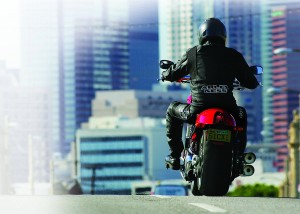
We could definitely feel more power all through the rev range compared to the 92-inch motor. The engine is redlined at 5,500 rpm and pulls strongly from just above idle to about 4,500, where it seems to begin leveling off before the rev limiter cuts in. This added power makes passing a breeze, just zing it down a cog and speed picks up quickly.
Victory states that the Hammer’s output is 88 horsepower at 4,500 rpm and 110 lb-ft at 2,500 revs, up by 10 horses and 22 lb-ft compared to the 92-inch version (measured at the crankshaft). On Barnett’s Dynojet dynamometer we recorded 77.1 rear-wheel horsepower at 4,600 rpm and 98.4 lb-ft of torque at 2,700 rpm from our test bike, a production-intent model at the fifth of eight stages in Victory’s build-proofing process-stage nine is production. We believe our test bike to be representative of what you can buy, however.
On hot days a lot of heat comes off the right rear portion of the engine right above the exhaust pipes, especially in traffic-more horsepower equals more heat. Also, some of the bikes at the introduction and our test machine had problems with their starters being unable to crank the engines when they were hot due to the higher load. We were assured this would be corrected before production began.
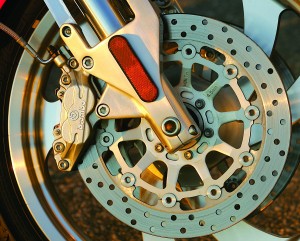
Clutch-lever effort appears to be slightly higher to handle the greater torque output. However, the required pull is still reasonable and it modulates well with no chatter or gabbiness.
With extra torque available, the Hammer drives through a new six-cog gearbox that has a taller final ratio. Shifting is smooth and quick for a cruiser and there’s less gear noise. First through fifth gear are the same as on the regular Vegas models, but sixth is an overdrive of 13.8 percent. This makes for a nice, relaxed 2,100 rpm at 60 mph, down about 300 from fifth gear. The engine is tractable enough that you can lug it down to about 2,000 in sixth, or slightly less in lower gears. Due to the larger pistons there’s slightly more vibration from the solid-mounted, counterbalanced powerplant, but it doesn’t become noticeable until about 4,000 revs. With the tall gearing, the only time you’ll hit that rpm is when accelerating hard.
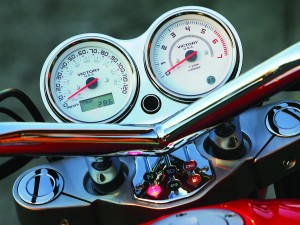
If you want even more power, S&S Cycle (the well-known aftermarket supplier of V-twin engines and accessories) will soon offer performance kits, including stroker crankshafts, through Victory dealers. We got to try out a prototype bike with a power kit on it and it was noticeably faster than stock, although a few fuel-injection glitches were still being worked out. A 106-cubic-inch stroker kit should be out this spring. Maximum power with the most radical kit will reportedly be around 115 crankshaft horsepower. When the final details are worked out the information should be available through Victory dealers and the companies’ Web sites.
Final drive is via a stronger carbon-fiber-reinforced toothed belt. It’s narrower to allow tire clearance but the pulleys are both larger in diameter to distribute the stresses. Victory tells us that with those changes the belt should last about 100,000 miles.
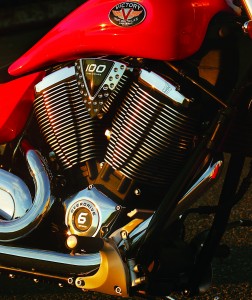
Up front you’ll find a male-slider cartridge fork, upgraded from the regular Vegas’ conventional setup. It feels more compliant and better-riding than the Vegas fork, which is a welcome change. Damping and suspension control seem better than on the standard-issue Vegas. In back a single shock that’s adjustable for preload handles the weight. Due to the higher unsprung weight and sidewall stiffness of the 250 tire this end rides harder than the Vegas.
Another upgrade is the dual-disc Brembo front brakes which help haul the Hammer down; an excellent addition considering the additional power on hand. They provide strong, consistent and fade-free stops, but required slightly more lever effort than we expected.
Seating is style-oriented, with comfort sufficient for rides of moderate length. There’s also a removable pillion cover that can be stored on an optional front flyscreen. It looks good when it’s in place; when it’s removed three holes and a grab handle are visible.
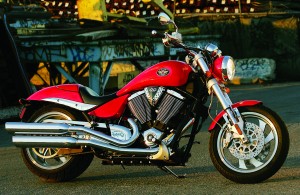
Unique to the Hammer is a fat, wide handlebar that forms a V shape and flares out straight to the sides. Perched in front of that is a pair of full-sized analog gauges, a speedo and tach, that let riders know just how rapid is their progress. There’s just a single trip odometer and no clock or other frippery; keep it simple is the theme. The instrument pods are mounted high, which puts them near the rider’s line of sight. They look nice in gleaming chrome.
Fuel mileage varied from a low of 34.3 to a high of 38.2, with an average of 36.2 mpg. With a 4.5-gallon tank, that pencils out to an approximate range of 163 miles to empty. Typically the low-fuel lamp came on at about 130 miles.
Avon and Metzeler were the pioneers in the realm of wide rear tires. That fat Dunlop Elite 3 250-width rear gummy was developed in collaboration with Victory’s engineers specifically for this bike and it’s said to be the tire firm’s first attempt at such big motorcycle rubber. The 250 width has a significant effect on the bike’s ride and handling; it requires noticeably more effort to turn the Hammer and hold it in a corner than the regular Vegas models. The higher unsprung weight and stiffer sidewalls also make the ride firmer, and keep in mind that a wide rear tire in combination with a narrow front can be real tricky in the rain or on wet pavement.
At $16,499 the Hammer has a number of upscale features that the $14,999 Vegas does not, such as the premium fork, extra front brake, larger displacement and six-speed transmission. That’s a lot of goodies for $1,500. Some of the latest V-twin cruisers have larger engines, but the bikes themselves have become so large that potential buyers may be turned off by the massiveness. At 704 pounds with a 65.7-inch wheelbase the Hammer is full-sized, yet smaller than these behemoths, while still offering 100 cubes of displacement and a lot of bling bling. So if you’re shopping for a “factory custom” bike with a warranty at a reasonable price, this may be it. The year 2005 may turn out to be a good vintage for Victory, indeed.







